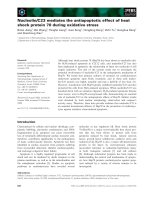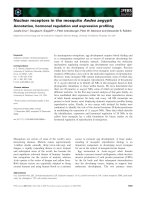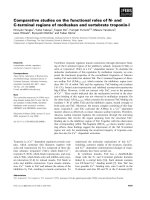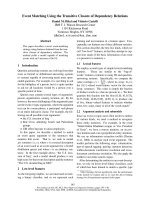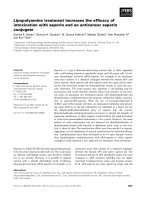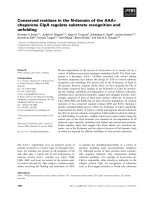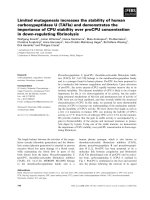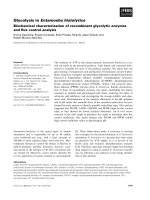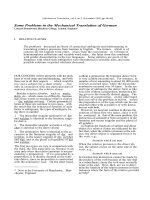Báo cáo khoa học: Lipopolyamine treatment increases the efficacy of intoxication with saporin and an anticancer saporin conjugate doc
Bạn đang xem bản rút gọn của tài liệu. Xem và tải ngay bản đầy đủ của tài liệu tại đây (769.93 KB, 12 trang )
Lipopolyamine treatment increases the efficacy of
intoxication with saporin and an anticancer saporin
conjugate
Sandra E. Geden
1
, Richard A. Gardner
2
, M. Serena Fabbrini
3
, Masato Ohashi
4
, Otto Phanstiel IV
2
and Ken Teter
1
1 Department of Molecular Biology and Microbiology and Biomolecular Science Center, University of Central Florida, FL, USA
2 Department of Chemistry and Biomolecular Science Center, University of Central Florida, FL, USA
3 Istituto Biologia e Biotecnologia Agraria, CNR, Milan, Italy
4 Okazaki Institute for Integrative Bioscience, National Institutes of Natural Sciences, Okazaki, Japan
Saporin is a lethal 30 kDa ribosome-inactivating protein
from the plant Saponaria officinalis [1]. The toxin lacks
an efficient cell-binding moiety and therefore exhibits
low in vivo activity. However, it is possible to append
saporin with a specific cell-binding motif. Urokinase
plasminogen activator (uPA)-saporin, for example, is an
anticancer toxin that consists of a chemical conjugate
between the human uPA and native saporin [2]. The
N-terminal domain of uPA specifically targets the toxin
conjugate to uPA receptors (uPARs) that are highly
expressed in human breast, colon, and prostate cancers
[2–5]. uPA-saporin can thus selectively target and kill
Keywords
anticancer therapy; endosome; intracellular
trafficking; plant ribosome-inactivating
protein; polyamine
Correspondence
K. Teter, Biomolecular Research Annex,
12722 Research Parkway, Orlando,
FL 32826, USA
Fax: +1 407 384 2062
Tel: +1 407 882 2247
E-mail:
(Received 12 June 2007, revised 20 July
2007, accepted 23 July 2007)
doi:10.1111/j.1742-4658.2007.06008.x
Saporin is a type I ribosome-inactivating protein that is often appended
with a cell-binding domain to specifically target and kill cancer cells. Uroki-
nase plasminogen activator (uPA)-saporin, for example, is an anticancer
toxin that consists of a chemical conjugate between the human uPA and
native saporin. Both saporin and uPA-saporin enter the target cell by endo-
cytosis and must then escape the endomembrane system to reach the cyto-
solic ribosomes. The latter process may represent a rate-limiting step for
intoxication and would therefore directly affect toxin potency. In the pres-
ent study, we document two treatments (shock with dimethylsulfoxide and
lipopolyamine coadministration) that generate substantial cellular sensitiza-
tion to saporin ⁄ uPA-saporin. With the use of lysosome-endosome X
(LEX)1 and LEX2 mutant cell lines, an endosomal trafficking step preced-
ing cargo delivery to the late endosomes was identified as a major site for
the dimethylsulfoxide-facilitated entry of saporin into the cytosol.
Dimethylsulfoxide and lipopolyamines are known to disrupt the integrity of
endosome membranes, so these reagents could facilitate the rapid movement
of toxin from permeabilized endosomes to the cytosol. However, the same
pattern of toxin sensitization was not observed for dimethylsulfoxide- or
lipopolyamine-treated cells exposed to diphtheria toxin, ricin, or the cata-
lytic A chain of ricin. The sensitization effects were thus specific for saporin,
suggesting a novel mechanism of saporin translocation by endosome disrup-
tion. Lipopolyamines have been developed as in vivo gene therapy vectors;
thus, lipopolyamine coadministration with uPA-saporin or other saporin
conjugates could represent a new approach for anticancer toxin treatments.
Abbreviations
CHO, Chinese hamster ovary; DT, diphtheria toxin; EC
50
, half-maximal effective concentration; ER, endoplasmic reticulum; ERAD,
ER-associated degradation; LEX, lysosome-endosome X; LT IIb, Escherichia coli heat-labile toxin IIb; uPA, urokinase plasminogen activator;
uPAR, uPA receptor.
FEBS Journal 274 (2007) 4825–4836 ª 2007 The Authors Journal compilation ª 2007 FEBS 4825
these cancer cells. Other saporin conjugates, chimeras,
and immunotoxins have also been developed as antican-
cer agents [6].
After binding to the cell surface, saporin and anti-
cancer saporin conjugates must enter the cytosol to
inactivate the ribosomes. This event may represent a
rate-limiting step for the intoxication process and
could therefore directly affect toxin potency. Efficient
toxin delivery to the cancer cell cytosol would accord-
ingly enhance the therapeutic value of anticancer sapo-
rin conjugates. Unfortunately, saporin passage into the
cytosol remains a poorly understood process.
Both saporin and anticancer saporin conjugates
enter the target cell by endocytosis and then escape the
endomembrane system to reach their cytosolic target
[7–11]. Other toxins that follow this general pathway
exit the endomembrane system from either acidified
endosomes or the endoplasmic reticulum (ER) [12].
These toxins generally exhibit an AB structural organi-
zation that consists of an enzymatic A subunit and a
cell-binding B subunit. AB toxins that move from the
endosomes to the cytosol undergo an acid-dependent
conformational change in the translocation domain
that creates a pore into the endosome membrane,
which permits passage of the toxin catalytic subunit
into the cytosol. A second category of AB toxins trav-
els from the endosomes to the Golgi apparatus en
route to an ER translocation site. These ER-translo-
cating toxins pass through the Sec61 translocon, a pre-
existing pore in the ER membrane, in order to move
from the ER to the cytosol. For both endosome and
ER exit sites, A ⁄ B subunit dissociation and A chain
unfolding occur before or during toxin export. The site
of endomembrane escape for saporin, which can be
viewed as a toxin A chain without the corresponding
B subunit, remains uncertain because its intracellular
transport route bypasses the Golgi apparatus [9].
In this work, our studies to delineate the route of sa-
porin entry into the cytosol have identified two experi-
mental conditions that generate significant cellular
sensitization to saporin. Both reagents used for these
conditions (dimethylsulfoxide or polycationic lipopoly-
amines) can disrupt the integrity of endosome mem-
branes [13,14]. Neither reagent generated comparable
levels of cellular sensitization to AB toxins or to the
isolated A chain of the plant toxin ricin. Thus, there
appeared to be a synergistic effect between saporin
and dimethylsulfoxide or lipopolyamine, which
resulted in permeabilization of the endosome mem-
brane and direct delivery of the toxin to the cytosol.
Additional studies identified an endosomal trafficking
step preceding cargo delivery to the late endosomes as
a major site for the dimethylsulfoxide-facilitated entry
of saporin into the cytosol. Dimethylsulfoxide- or
lipopolyamine-induced toxin sensitization was also
observed in a model cancer cell line exposed to the
anticancer toxin uPA-saporin. Because lipopolyamines
have been developed as nontoxic in vivo gene therapy
vectors [14–16], lipopolyamine coadministration with
uPA-saporin or other saporin conjugates could repre-
sent a new approach for anticancer toxin treatments.
Results and Discussion
Saporin intoxication does not require the
mechanism of ER-associated degradation
Expression of an anticancer saporin chimera in the ER
of Xenopus oocytes produced a drastic inhibition of
translation in the RNA-injected cells [17]. Injection of
neutralizing saporin antibodies in the host cell cytosol
abolished the toxic effect, indicating that some of
the newly synthesized chimeric toxin mislocalized into
the cytosol. Most toxins that reach the ER exploit the
quality control system of ER-associated degradation
(ERAD) for translocation to the cytosol [18,19]. An
ER-to-cytosol export of this saporin chimera could, in
principle, also result from ERAD activity. This would
be consistent with the observation that the 3D struc-
ture of saporin can be superimposed with the A chain
of ricin, an ER-translocating toxin [20]. Yet, even cor-
rectly folded proteins are exported from the ER to the
cytosol to some small extent. If this occurred for the
saporin chimera, it could affect translation, even
though only a small pool of newly synthesized toxin
was mistakenly exported to the oocyte cytosol. Alter-
natively, the inhibition of translation could have
resulted from inefficient toxin insertion into the ER.
To detect a functional role for ERAD in intoxica-
tion with exogenously applied saporin, we generated
toxin dose–response curves for wild-type and mutant
Chinese hamster ovary (CHO) cells (Fig. 1). The
mutant cell lines exhibit defects in the ERAD pathway
that generate substantial cellular resistance to a num-
ber of established ER-translocating toxins [21,22].
Accelerated ERAD activity in mutant clones 23
and 24 [22] conferred resistance to Escherichia coli
heat-labile toxin IIb (LT IIb; Fig. 1A), a known ER-
translocating toxin, but did not inhibit intoxication
with saporin (Fig. 1B). The disruption of ERAD-medi-
ated toxin translocation in mutant clones 16 and 46
[21] also conferred resistance to LT IIb (Fig. 1C) but,
again, no inhibitory effect on saporin could be
detected (Fig. 1D). Because at least two distinct defects
in the ERAD system failed to generate resistance
against saporin, this toxin would appear to utilize an
Toxin translocation by endosome disruption S. E. Geden et al.
4826 FEBS Journal 274 (2007) 4825–4836 ª 2007 The Authors Journal compilation ª 2007 FEBS
ERAD-independent mechanism of translocation across
the ER membrane. Alternatively, translocation of
exogenous saporin into the cytosol may have occurred
from an organelle other than the ER.
Internalized saporin and uPA-saporin have not been
detected in the Golgi apparatus or the ER [9]. Further-
more, saporin intoxication is not affected by the inhibi-
tion of ER-to-Golgi ⁄ Golgi-to-ER vesicular trafficking
that is elicited by treatment with the fungal drug brefel-
din A [9]. Intoxication with several other ER-translo-
cating toxins is effectively blocked by brefeldin A [18].
Finally, saporin does not follow the intracellular trans-
port routes utilized by ricin holotoxin and ricin A chain
to enter the host cell cytosol from the ER [9]. These
observations, combined with our results from the
ERAD-defective CHO mutants, suggested that saporin
translocation may actually occur from the endosomes.
A postintoxication shock with dimethylsulfoxide
generates significant cellular sensitization to
saporin
Exit of saporin from the endomembrane system would
likely occur by a novel mechanism, different from the
established pathway described for diphtheria toxin
(DT). Toxins such as DT that move from the endo-
somes to the cytosol rely upon an acid-induced confor-
mational change in a toxin subunit to facilitate export.
Endosome alkalinization thus generates resistance to
toxins that move from the endosomes to the cytosol.
However, treatment with chloroquine or bafilomy-
cin A1 (two drugs that alkalinize the endosomal com-
partments) does not inhibit saporin intoxication [9].
The putative endosome-to-cytosol export of saporin
would therefore be distinct from the mechanism uti-
lized by other toxins that follow this translocation
route.
The DEAE-dextran transfection method, a procedure
that involves disruption of the endosomal membrane,
represented an alternative pathway for entering the
cytosol from the endosomes. The DEAE-dextran com-
plex is a polycationic reagent that, by virtue of its physi-
cal properties, disrupts the endosomal membrane and
thereby allows DNA to enter the cytosol [15,23]. Details
of the mechanism by which endosome disruption occurs
is still a matter of debate, but recent lipopolyamine
DNA transfection protocols are thought to operate by
a similar mechanism of endosomal disruption [14].
CD
AB
Fig. 1. Effect of ERAD dysfunction on sapo-
rin intoxication. Cellular sensitivity to LT IIb
or saporin was monitored in wild-type CHO
cells and mutant CHO cells with aberrant
ERAD activity. (A,B) Intoxication with LT IIb
(A) or saporin (B) was monitored in mutant
cell lines with accelerated ERAD activity
(clones 23 and 24). (C,D) Intoxication with
LT IIb (C) or saporin (D) was monitored in
mutant cell lines with attenuated ERAD-
mediated translocation (clones 16 and 46).
For LT IIb intoxication assays, cells were
incubated with varying concentrations of
toxin for 2 h before intracellular cAMP levels
were quantified with a [
125
I]cAMP competi-
tion assay. LT IIb is an ER-translocating
toxin that stimulates cAMP production in
the target cell. The mean ± SEM is shown
for four independent experiments with tripli-
cate samples. For saporin intoxication
assays, cells incubated with varying concen-
trations of toxin for 8 h were chased in
toxin-free media for 16 h before protein syn-
thesis levels were quantified. The mean ±
SEM is shown for at least three indepen-
dent experiments with triplicate samples.
S. E. Geden et al. Toxin translocation by endosome disruption
FEBS Journal 274 (2007) 4825–4836 ª 2007 The Authors Journal compilation ª 2007 FEBS 4827
Saporin has an extremely high pI (approximately 10)
and thus bears some biochemical similarity to DEAE-
dextran (pI ¼ 10.8) and lipopolyamine (pI > 9) trans-
fection reagents. As such, we hypothesized that saporin
enters the cytosol by disrupting an endosome mem-
brane. Such a process would not require the unfolding
of saporin, which indeed appears to be an extremely
stable protein [24]. The low level of toxicity obtained
with exogenously applied saporin suggests that this
putative endosome disruption mechanism is a low fre-
quency event. DEAE-dextran tranfections are also low
frequency events, but the efficiency of transfection is
greatly enhanced by a 2-min shock with dimethylsulf-
oxide at the end of the DEAE-dextran exposure [25].
Dimethylsulfoxide shock provides an additional, effi-
cient mechanism for endosome permeabilization [13].
Thus, we reasoned that a dimethylsulfoxide shock
would enhance the potency of saporin.
We exposed cells to saporin for 8 h and then, as per
the DEAE-dextran transfection method, initiated a
2-min shock with 10% dimethylsulfoxide in toxin-free
media (Fig. 2). The cells were then incubated for
another 16 h in the absence of saporin and
dimethylsulfoxide before determining the extent of
intoxication. As shown in Fig. 2A, cells shocked with
dimethylsulfoxide were 125-fold more sensitive to
saporin at the half-maximal effective concentration
(EC
50
) than cells that did not receive the shock treat-
ment. A 2-min dimethylsulfoxide shock before saporin
intoxication did not result in substantial toxin sensiti-
zation (Fig. 2B); thus, the dramatic sensitization from
a post-toxin dimethylsulfoxide shock cannot result
from a general negative effect of dimethylsulfoxide on
cell health. Indeed, the dimethylsulfoxide shock treat-
ment only reduced protein synthesis levels in unintoxi-
cated cells to 80% of the untreated, unintoxicated
control level. Dimethylsulfoxide treatment may have
transiently permeabilized the cell membrane and
allowed any remaining residual toxin to directly enter
the cytosol. To control for this possibility, we (a)
placed cells in saporin-containing media; (b) immedi-
ately removed the media; (c) shocked the cells for
2 min with dimethylsulfoxide in toxin-free media; (d)
returned the saporin-containing media to the cells for
8 h; and (e) chased the cells overnight in the absence
of toxin. This procedure, in which the dimethylsulfox-
ide shock precedes the 8 h toxin incubation but occurs
after a very brief exposure to saporin, did not result in
substantial sensitization to saporin (Fig. 2B). Signifi-
cant toxin sensitization was only seen when the
dimethylsulfoxide shock occurred after an 8 h toxin
incubation permitted saporin endocytosis (Fig. 2A).
Dimethylsulfoxide treatment thus appeared to specifi-
cally affect the endocytosed pool of saporin.
Endocytic trafficking is involved with the
dimethylsulfoxide-induced sensitization
to saporin
To confirm that endocytosis was required for the
dimethylsulfoxide sensitization effect, we repeated our
postintoxication shock protocol with cells exposed to
saporin for 4 h at 4 °C (Fig. 3A). Endocytosis is effec-
tively blocked at 4 °C. Saporin intoxication was also
blocked at this temperature, as exposure of up to
25 lg saporinÆ mL
)1
at 4 °C was not sufficient to
A
B
Fig. 2. Effect of dimethylsulfoxide (DMSO) on saporin intoxication. CHO cells were incubated for 8 h with varying concentrations of saporin.
The cells were then chased in toxin-free media for 16 h before protein synthesis levels were monitored. Results were expressed as percent-
ages of the values obtained from unintoxicated cells treated in an identical manner to the corresponding toxin-exposed cells. The mean ±
SEM is shown for at least three independent experiments with triplicate samples. (A) A 2 min shock with 10% DMSO followed the toxin
incubation (+ DMSO). (B) A 2 min shock with 10% DMSO preceded the toxin incubation (DMSO–toxin), or cells were placed in toxin-
containing media; the media was removed; the cells were shocked for 2 min with 10% DMSO; toxin-containing media was returned to the
cells for 8 h; and the cells were chased 16 h without toxin (toxin–DMSO–toxin).
Toxin translocation by endosome disruption S. E. Geden et al.
4828 FEBS Journal 274 (2007) 4825–4836 ª 2007 The Authors Journal compilation ª 2007 FEBS
produce an EC
50
value. In this assay, an overnight
chase at 37 °C followed the 4 °C toxin exposure. Thus,
the surface-bound toxin present at 4 °C was endocyto-
sed during the 37 °C chase to generate a minor but
productive intoxication. Some degree of toxin sensiti-
zation was seen when cells were shocked with dimethyl-
sulfoxide after exposure to saporin at 4 °C. However,
the two-fold level of sensitization observed for this
4 °C condition (compared to the 37 °C intoxication)
was similar to the three-fold level of sensitization doc-
umented for cells shocked with dimethylsulfoxide
before toxin exposure (Fig. 2B). This indicated that a
nonspecific dimethylsulfoxide effect was responsible
for toxin sensitization when cells were exposed to
saporin at 4 °C. The two-fold level of saporin sensiti-
zation for dimethylsulfoxide-treated cells incubated
with toxin at 4 °C was clearly attenuated in compari-
son to the 125-fold level of saporin sensitization for
dimethylsulfoxide-treated cells incubated with toxin at
37 °C (Fig. 2A). Endocytosis was therefore required
for the dramatic dimethylsulfoxide-induced sensiti-
zation to saporin.
Dimethylsulfoxide-induced saporin sensitization was
also examined in the lysosome-endosome X (LEX)1
and LEX2 mutant cell lines (Fig. 3B,C). The LEX1
mutant is defective in transport from the late endo-
somes to the lysosomes, whereas the LEX2 mutant
accumulates multivesicular bodies that serve as (a) sort-
ing stations and (b) transport intermediates between
the early endosomes and late endosomes [26,27]. LEX1
cells were more sensitive to saporin than the parental
cells from which the LEX1 and LEX2 mutants were
derived (Fig. 3B). However, the LEX1 and parental
cells produced identical toxin dose–response curves
after dimethylsulfoxide shock (Fig. 3B). By contrast,
the LEX2 cells were more sensitive to saporin intoxica-
tion than the parental cells both with and without a
dimethylsulfoxide shock (Fig. 3C). The LEX2 and
LEX1 cells exhibited similar levels of saporin sensitivity
in the absence of dimethylsulfoxide shock.
Collectively, our results suggest an endosomal traf-
ficking step preceding cargo delivery to the late endo-
somes is the major site for dimethylsulfoxide-facilitated
entry of saporin into the cytosol. The LEX2 inhibition
of cargo delivery to the late endosomes would thereby
increase the pool of saporin available for passage from
the early endosomes and ⁄ or multivesicular bodies to
the cytosol. This, in turn, would generate an elevated
state of dimethylsulfoxide-induced toxin sensitivity in
the LEX2 cells relative to the parental and LEX1 cells.
Selective permeabilization of the early endosomes
and ⁄ or multivesicular bodies by dimethylsulfoxide
treatment would explain why toxin accumulated in the
late endosomes of LEX1 cells did not generate a simi-
lar elevated state of dimethylsulfoxide-induced toxin
sensitivity. Because both LEX2 and LEX1 cells were
more sensitive to saporin than the parental cells in
the absence of dimethylsulfoxide shock, the late
ABC
Fig. 3. Role of endocytic trafficking in dimethylsulfoxide (DMSO)-induced sensitization to saporin. (A) CHO cells were preincubated for
30 min at 4 °C in serum-free medium buffered with 20 m
M Hepes pH 7.2. The cells were then incubated in Hepes-buffered medium with
varying concentrations of saporin for an additional 4 h at 4 °C. For one set of cells, a 2 min 37 °C shock with 10% DMSO followed the toxin
incubation (4 °C + DMSO). The cells were then chased in toxin-free media for 20 h before protein synthesis levels were monitored. A third
set of cells were kept at 37 °C for the entire experiment, including the 4 h toxin exposure. (B,C) Varying concentrations of saporin were
added at 37 °C for 4 h to LEX1 cells (B), LEX2 cells (C), and the parental cells from which the LEX mutants were derived. For one set of
each cell type, a 2 min shock with 10% DMSO followed the toxin incubation (+ DMSO). The cells were then chased in toxin-free media for
20 h before protein synthesis levels were monitored. Data in (B) and (C) were generated simultaneously but are presented separately for
clarity. For all experiments, results were expressed as percentages of the values obtained from unintoxicated cells treated in an identical
manner to the corresponding toxin-exposed cells. The mean ± SEM is shown for least four independent experiments with triplicate
samples.
S. E. Geden et al. Toxin translocation by endosome disruption
FEBS Journal 274 (2007) 4825–4836 ª 2007 The Authors Journal compilation ª 2007 FEBS 4829
endosomes may also serve as a saporin translocation
site. The inhibition of cargo delivery to the lysosomes
in either LEX2 or LEX1 cells would again increase the
pool of saporin available for passage from the endo-
somes to the cytosol and would thereby generate an
elevated state of toxin sensitivity in the LEX mutants.
Escape from the endomembrane system is a
possible rate-limiting step in saporin intoxication
We also performed a dimethylsulfoxide shock on CHO
cells that had only been exposed to saporin for 1 h
(Table 1). This procedure resulted in an EC
50
of
1 lgÆmL
)1
after just 3 h of chase. Without a
dimethylsulfoxide shock, the effects of intoxication
were observed 24 h after the initial toxin exposure but
not at 4 h postexposure. Furthermore, with an over-
night chase in the absence of dimethylsulfoxide shock,
a 1 h toxin exposure was only slightly less effective
than the 4 h and 8 h toxin exposures. These data indi-
cated that saporin can enter the endomembrane system
relatively quickly (within an hour), but its exit from
the endomembrane system and the corresponding man-
ifestation of toxicity occur slowly. Saporin escape from
the endomembrane system thus appeared to represent
a rate-limiting step during the intoxication process.
Dimethylsulfoxide treatment accelerated the rate and
extent of saporin entry into the cytosol, which in turn
greatly enhanced toxin potency.
Dimethylsulfoxide treatment does not induce
substantial sensitization to other toxins
To determine the specificity of dimethylsulfoxide-
induced toxin sensitization, we repeated our experi-
ment with cells exposed to AB toxins with established
endosome (i.e. DT) or ER (i.e. ricin) exit sites (Fig. 4).
A dimethylsulfoxide shock had no effect on DT
Table 1. Time course of saporin intoxication. CHO cells were
exposed to varying concentrations of saporin for 1–8 h. Inhibition of
protein synthesis was then quantified after a total time interval
(toxin exposure + chase) of 4 or 24 h. EC
50
values were calculated
from four independent experiments with triplicate samples.
Toxin exposure
EC
50
(lgÆmL
)1
)
4 h 24 h
1h >25
a
8
4h >25
a
2.5
8h – 2
1 h + dimethylsulfoxide shock 1 –
a
Cells treated with 25 lg saporinÆmL
)1
exhibited approximately
85% of the protein synthesis levels recorded for unintoxicated con-
trol cells.
AB
CD
Fig. 4. Effect of dimethylsulfoxide (DMSO)
on intoxication with diphtheria toxin, ricin, or
ricin A chain. CHO cells were incubated for
4 h with varying concentrations of DT (A),
ricin (B), or ricin A chain (C). In (D), LEX2
cells and their parental cells were incubated
for 4 h with varying concentrations of ricin
A chain. Where indicated, a 2 min shock
with 10% DMSO followed the toxin incuba-
tion (+ DMSO). The cells were then chased
in toxin-free media for 20 h before protein
synthesis levels were monitored. Results
were expressed as percentages of the
values obtained from unintoxicated cells
treated in an identical manner to the
corresponding toxin-exposed cells. The
mean ± SEM is shown for at least three
independent experiments with triplicate
samples.
Toxin translocation by endosome disruption S. E. Geden et al.
4830 FEBS Journal 274 (2007) 4825–4836 ª 2007 The Authors Journal compilation ª 2007 FEBS
(Fig. 4A) and only resulted in a 2.5-fold level of sensi-
tization to ricin (Fig. 4B). This low level of sensitiza-
tion was also seen for cells that were shocked with
dimethylsulfoxide before the addition of saporin and
for cells shocked with dimethylsulfoxide after a 4 °C
toxin incubation (Figs 2B and 3A). Sandvig et al. [28]
have further shown that cells coincubated with
dimethylsulfoxide and either DT or ricin for prolonged
incubations are actually more resistant to these toxins
than cells incubated without dimethylsulfoxide. Collec-
tively, our results demonstrated that dimethylsulfoxide
does not elicit a general sensitization to AB toxins with
established endosome or ER exit sites.
It was also possible that dimethylsulfoxide alone
was responsible for membrane disruption and that
saporin played no active role in the process. With this
scenario, DT and ricin might not be more toxic after a
dimethylsulfoxide shock because they would enter the
cell as intact AB toxins and not as isolated, catalyti-
cally active A chains. To control for this possibility,
we repeated the dimethylsulfoxide shock experiment
with cells exposed to free ricin A chain (Fig. 4C). If
dimethylsulfoxide alone permeabilized the endosome
membrane, then the dimethylsulfoxide shock would
increase the potency of ricin A chain because the toxin
would move directly from the endosomes to the cyto-
sol. This could occur even though ricin A chain nor-
mally moves from the endosomes to the ER before
translocation into the cytosol [9,29]. We indeed
detected a ten-fold increase in cellular sensitivity to
ricin A chain after the dimethylsulfoxide shock, as
would be expected from A chain escape during transit
through the endosome compartments. However, the
relative effect of sensitization to ricin A chain was sub-
stantially lower than the 125-fold level of dimethylsulf-
oxide-induced sensitization to saporin. In the absence
of dimethylsulfoxide treatment, saporin was only
three-fold more toxic than ricin A chain at the EC
50
value (Figs 2 and 4C), so the large differences between
saporin and ricin A chain sensitization were unlikely
to reflect possible differences in the intrinsic toxin
activities. Furthermore, our evaluations of toxin sensi-
tization involved internal standard controls: saporin
intoxication with dimethylsulfoxide shock was
expressed as a relative value of saporin intoxication
without dimethylsulfoxide shock, whereas ricin A
chain intoxication with dimethylsulfoxide shock was
expressed as a relative value of ricin A chain intoxica-
tion without dimethylsulfoxide shock. The dramatic
increase in cellular sensitivity to saporin after a
dimethylsulfoxide shock thus appeared to result from a
synergistic toxin ⁄ dimethylsulfoxide effect that was
more profound with saporin.
We found that the elevated state of dimethylsulfox-
ide-induced toxin sensitivity in the LEX2 cells also dif-
fered for saporin and ricin A chain. By contrast to the
dimethylsulfoxide ⁄ saporin experiment (Fig. 3C), LEX2
cells and their parental cells produced identical dose–
response curves for a dimethylsulfoxide⁄ ricin A chain
experiment (Fig. 4D). The LEX2 and parental cells also
exhibited similar sensitivities to ricin A chain in the
absence of dimethylsulfoxide shock (Fig. 4D), which
was again distinct from the results of the saporin experi-
ment (Fig. 3C). Saporin and ricin A chain normally
follow separate pathways into the cytosol [9,29]; these
results demonstrated that the two toxins also follow
separate trafficking ⁄ translocation itineraries into the
cytosol after a dimethylsulfoxide shock. Thus, dimethyl-
sulfoxide treatment appeared to specifically enhance the
productive pathway of saporin intoxication.
Lipopolyamine treatment enhances saporin
intoxication
DNA transfections with lipopolyamines can effectively
disrupt the endosome membrane without a dimethyl-
sulfoxide shock [14]. Thus, similar to the dimethylsulf-
oxide shock, coadministration of lipopolyamines with
saporin should generate significant cellular sensitization
to the toxin. We tested this prediction using three lipo-
polyamine vectors with different relative DNA transfec-
tion efficiencies [16]. These lipopolyamines are shown
in Figure 5; they differ in the number of evenly
spaced positive charges along the polyamine scaffold.
O
O
O
O
O
O
N
H
2
NH
3
+
+
2Cl
_
1
N
H
2
H
2
N
NH
3
+
+
+
3Cl
_
2
N
H
2
H
2
N
N
H
2
NH
3
+
+
+
+
4Cl
_
3
Fig. 5. Lipopolyamine structures. The
molecular weights of 1–3, as previously
described [16], are 784, 891, and
999 gÆmol
)1
, respectively.
S. E. Geden et al. Toxin translocation by endosome disruption
FEBS Journal 274 (2007) 4825–4836 ª 2007 The Authors Journal compilation ª 2007 FEBS 4831
Cells coincubated with saporin and 5 lgÆmL
)1
of lipo-
polyamine were between 33- and 83-fold more sensitive
to saporin at the EC
50
value than cells incubated with
saporin in the absence of lipopolyamine (Table 2).
Lipopolyamine treatment alone reduced protein synthe-
sis to either 60% (lipopolyamines 1 and 2) or 80%
(lipopolyamine 3) of the untreated, unintoxicated con-
trol level. Internal controls accounted for this lipopoly-
amine-induced effect on protein synthesis. Interestingly,
the degree of saporin sensitization correlated directly
with the transfection efficacy of the lipopolyamine. By
contrast, the three tested lipopolyamines did not sensi-
tize cells to DT (not shown) and generated only rela-
tively modest levels of sensitization to ricin, with the
exception of lipopolyamine 3, which actually conferred
resistance to the ricin holotoxin. Sensitization to ricin
A chain was detected, but there was an inverse relation-
ship between the extent of lipopolyamine-induced sensi-
tization to saporin versus free ricin A chain. Thus, as
with the extent of dimethylsulfoxide-induced toxin sen-
sitization and the susceptibility of LEX2 cells to intoxi-
cation, significant differences were recorded for the
cellular response to saporin versus ricin A chain. The
distinct pattern of lipopolyamine-induced sensitization
to ricin A chain could result from membrane destabili-
zation by ricin A chain [30,31] and⁄ or lipopolyamine
disruption of endo-lysosomal compartments other than
the early endosomes and multivesicular bodies [14,15].
Future studies will examine these possibilities and their
implications for the delivery of immunotoxins contain-
ing ricin A chain. Here, a specific sensitization effect
that directly corresponded to lipopolyamine transfec-
tion efficiency was documented for saporin intoxication.
Lipopolyamine treatment enhances the potency
of uPA-saporin, an anticancer toxin conjugate
Lipopolyamines are being developed as nontoxic
in vivo gene therapy vectors [14–16]. These compounds
could accordingly be used as therapeutic agents to
increase the efficiency of cell killing by saporin-based
anticancer toxins. To examine this possibility in tissue
culture cells, we examined whether lipopolyamine 3
could sensitize a model cancer cell line to uPA-sapo-
rin (Fig. 6). LB6 murine fibroblasts and LB6 clone 19
cells that stably express the human uPAR were used
for this purpose [32]. Because many human cancer
cells overexpress the uPAR [3–5], LB6 clone 19 can
serve as a model cancer cell line to assess the efficacy
of anticancer toxin treatments [2,7,8]. Both LB6 and
LB6 clone 19 cells were used to distinguish general
cytotoxic effects from uPAR ⁄ cancer-specific cell kill-
ing. Lipopolyamine 3 was chosen for this work
because it was the most effective and least toxic of
the three lipopolyamines tested on CHO cells
(Table 2).
We first confirmed that LB6 and LB6 clone 19 cells
could be sensitized to native saporin by a dimethyl-
sulfoxide shock and by lipopolyamine treatment
(Fig. 6A,B). For these cells, the dimethylsulfoxide
shock reduced protein synthesis levels to 60% of the
untreated, unintoxicated control level. Treatment with
lipopolyamine 3 had no adverse effect on protein syn-
thesis. In our experimental conditions, native saporin
exhibited minimal toxicity against the LB6 (Fig. 6A)
and LB6 clone 19 cells (Fig. 6B). However, toxicity
was observed when the saporin-treated cells were sub-
jected to a dimethylsulfoxide shock and when lipopoly-
amine 3 was coadministered with saporin. The
dimethylsulfoxide shock generated substantially greater
sensitization to saporin than lipopolyamine treatment
for both LB6 and LB6 clone 19 cells. In comparison,
dimethylsulfoxide-treated CHO cells were only slightly
more sensitive to saporin than lipopolyamine-treated
CHO cells (Fig. 2A and Table 2). CHO cells were also
susceptible to saporin intoxication in the absence of
additional treatment (Fig. 2). Collectively, these obser-
vations suggested that the endosomes of LB6 and LB6
Table 2. Lipopolyamine-induced toxin sensitization. 5 lgÆmL
)1
of the stated lipopolyamine was administered to CHO cells with varying con-
centrations of toxin for a 4 h coincubation. EC
50
values from cells incubated in the absence or presence of lipopolyamine were then deter-
mined at 24 h postintoxication. Values were calculated from protein synthesis levels with 3–5 experiments per condition. The levels of
lipopolyamine-induced toxin sensitization (in comparison to toxin-treated cells incubated without lipopolyamine) are shown.
Lipopolyamine
Transfection
efficiency
a
Saporin
sensitization
Ricin
sensitization
Ricin A chain
sensitization
Compound 1 + 33-fold 8-fold 250-fold
Compound 2 ++ 63-fold 15-fold 200-fold
Compound 3 +++ 83-fold None
b
13-fold
a
Relative transfection efficiency as previously reported [16].
b
Cells exposed to compound 3 were highly resistant to ricin and exhibited, at a
toxin concentration of 10 ngÆmL
)1
, 64% of the protein synthesis levels recorded for the unintoxicated control cells. In comparison, cells incu-
bated with 10 ng ricinÆmL
)1
in the absence of lipopolyamine exhibited 22% of the protein synthesis levels recorded for unintoxicated control
cells.
Toxin translocation by endosome disruption S. E. Geden et al.
4832 FEBS Journal 274 (2007) 4825–4836 ª 2007 The Authors Journal compilation ª 2007 FEBS
clone 19 cells were more resistant to saporin ⁄ lipopoly-
amine membrane disruption than CHO cells. The
extent of lipopolyamine-induced toxin sensitization is
thus likely to vary amongst different cell types and
may depend upon endosome membrane composition.
We next determined whether LB6 and LB6 clone 19
cells could be sensitized to uPA-saporin by a
dimethylsulfoxide shock or lipopolyamine treatment
(Fig. 6C,D). As expected, uPA-saporin exhibited very
little toxicity against the parental LB6 cells, although
dimethylsulfoxide shock or lipopolyamine coadminis-
tration did result in some sensitization to the toxin
(Fig. 6C). LB6 clone 19 cells were susceptible to uPA-
saporin intoxication and were further sensitized to the
toxin by dimethylsulfoxide shock or lipopolyamine
coadministration (Fig. 6D). Dimethylsulfoxide- and
lipopolyamine-induced sensitization to uPA-saporin
were both several-fold higher in the LB6 clone 19 cells
than in the parental LB6 cells, indicating the specificity
of the sensitization effect for cells that express the
human uPAR. In the LB6 clone 19 cells, dimethylsulf-
oxide was more effective at uPA-saporin sensitization
than lipopolyamine coadministration. However, the
latter condition still produced an approximate ten-fold
level of toxin sensitization compared to cells incubated
with uPA-saporin in the absence of additional treat-
ment. Similar results were obtained after continuous
exposure of the LB6 clone 19 cells to uPA-saporin or
a uPA-saporin ⁄ lipopolyamine 3 mixture for 24 h (data
not shown). The similar EC
50
values for uPA-sapo-
rin ⁄ lipopolyamine 3 treatment after 4 h and 24 h of
toxin exposure again indicated that toxin escape from
the endomembrane system, rather than toxin endocyto-
sis, was the rate-limiting step for intoxication in these
experiments.
Conclusions
Dimethylsulfoxide shock or lipopolyamine treatment
greatly enhances the potency of endocytosed saporin
and uPA-saporin. The molecular basis for dimethyl-
sulfoxide- or lipopolyamine-induced toxin sensitization
remains to be elucidated, although the mechanism
most likely involves disruption of the endosome
membrane. Endosome disruption by the process of
photochemical internalization [33,34] or saponin
administration [35,36] has also been developed as a
method to introduce various type I ribosome inacti-
vating plant toxins into the target cell cytosol. The
present study suggests that endosome disruption can
AB
CD
Fig. 6. Effect of lipopolyamine treatment on
uPA-saporin intoxication. LB6 cells (A,C) and
LB6 clone 19 cells (B,D) were incubated for
4 h with varying concentrations of native
saporin (A,B) or uPA-saporin (C,D). The cells
were then chased in toxin-free media for
20 h before protein synthesis levels were
monitored. Results were expressed as per-
centages of the values obtained from un-
intoxicated cells treated in an identical
manner to the corresponding toxin-exposed
cells. The mean ± SEM is shown for three
independent experiments with triplicate
samples. Circles represent untreated, toxin-
exposed cells; triangles represent cells coin-
cubated with toxin and lipopolyamine 3;
squares represent cells that were subjected
to a dimethylsulfoxide shock following toxin
exposure.
S. E. Geden et al. Toxin translocation by endosome disruption
FEBS Journal 274 (2007) 4825–4836 ª 2007 The Authors Journal compilation ª 2007 FEBS 4833
successfully deliver these toxins to the cytosol because
of their particular intracellular trafficking and ⁄ or
translocation mechanisms.
Because lipopolyamines have been designed as
in vivo drug delivery vehicles, lipopolyamine coadmin-
istration may represent a novel mechanism to increase
the in vivo efficiency of cancer cell killing by saporin-
based toxins. Short-term exposures to saporin ⁄ lipo-
polyamine mixtures could be sufficient for treatment,
given that a maximal increase in cell killing was
achieved within the first four hours of LB6 clone 19
exposure to uPA-saporin ⁄ lipopolyamine 3. Future
studies will determine the in vivo efficacy of lipopoly-
amine-induced sensitization to saporin-based toxins.
Experimental procedures
Materials
Recombinant saporin isoform SAP3 [7] or seed-extracted
saporin from Sigma-Aldrich (St Louis, MO, USA) were
used to equal effect in cell killing assays. The anticancer
uPA-saporin conjugate, provided by U. Cavallaro, was
generated by conjugating seed-extracted saporin to an
N-succinimidyl-3-(2-pyridyldithio)propionate-derivatized pro-
uPA as previously described [2]. LT IIb, provided by
R. K. Holmes, was purified from E. coli strain HB101
transformed with the pTC100 expression plasmid [37].
Ricin A chain and ricin holotoxin were purchased from
Vector Laboratories, Inc. (Burlingame, CA, USA), whereas
DT was purchased from Sigma-Aldrich. LB6 control cells
and LB6 clone 19 cells that stably express the human
uPAR [32] were a generous gift from F. Blasi. ERAD-
defective CHO clones 16, 23, 24, and 46 were isolated from
a screen which challenged mutagenized cells with a combi-
nation of two lethal ER-translocating toxins, ricin and
Pseudomonas aeruginosa exotoxin A [21,22]. The LEX1 and
LEX2 cell lines were isolated by flow cytometry with a pro-
cedure designed to identify mutagenized cells defective in
the degradation of endocytosed low-density lipoprotein
[26,27]. The synthesis of lipopolyamines 1–3 has been
described previously [16].
Cell culture
CHO cells (both our lab stock of CHO-K1 and the parental
CHO cells for the LEX1 and LEX2 mutants), CHO
mutants, the LEX1 mutant, and the LEX2 mutant were all
grown under humidified conditions at 37 °C and 5% CO
2
in Ham’s F-12 media (Gibco BRL, Grand Island, NY,
USA) supplemented with 10% fetal bovine serum (Atlanta
Biologicals, Lawrenceville, GA, USA) and penicillin ⁄ strep-
tomycin (Gibco BRL). LB6 and LB6 clone 19 cells were
grown under humidified conditions at 37 °C and 5% CO
2
in Dulbecco’s modified Eagle’s medium (Gibco BRL) sup-
plemented with 10% fetal bovine serum and penicil-
lin ⁄ streptomycin.
DT, ricin, and saporin toxicity assays
The toxin-mediated inhibition of protein synthesis was
detected by [
35
S]methionine (PerkinElmer Life And Analyti-
cal Sciences, Inc., Waltham, MA, USA) incorporation into
the newly synthesized proteins of toxin-treated cells. Cells
were seeded at 50–80% confluency in 24-well plates and
grown overnight. Serum-free medium containing varying
concentrations of toxin was then added to the cells for 1, 4,
8, or 24 h. For incubations less than 24 h, the toxin-con-
taining medium was removed and replaced with complete
medium. The total duration of the intoxication (toxin expo-
sure + chase) was 24 h unless otherwise noted. Where
indicated, the cells were coincubated with toxin and
5 lg lipopolyamineÆmL
)1
or were shocked with 10%
dimethylsulfoxide in toxin-free, serum-free medium for
2 min before the chase was initiated.
After intoxication, cells were placed in methionine-free
medium for 30 min and were then exposed to approxi-
mately 1 lCi [
35
S]methionineÆmL
)1
for 15 min. Radio-
labeled cells were washed twice with ice-cold 10%
trichloroacetic acid in NaCl ⁄ P
i
before solubilization in
0.2 N NaOH. [
35
S]methionine incorporation into the newly
synthesized, precipitated proteins of the cell extracts was
determined by scintillation counting. Results from toxin-
treated cells were expressed as percentages of the values
obtained from control cells incubated without toxin. When
additional treatments (i.e. dimethylsulfoxide shock or
lipopolyamine administration) were performed on the
intoxicated cells, a corresponding control condition
(dimethylsulfoxide shock or lipopolyamine administration)
was performed for the control cells incubated without
toxin. Triplicate samples were used for all experiments.
The following toxin concentrations were used for toxicity
assays: DT, 1, 5, and 10 ngÆmL
)1
; ricin, 0.1, 0.5, 1, and ⁄ or
5ngÆmL
)1
; ricin A chain, 0.05, 0.1, 1, 5, 10, 25, and ⁄ or
50 lgÆmL
)1
; saporin, 0.01, 0.025, 0.05, 0.1, 1, 3, 5, 10,
and ⁄ or 25 lgÆmL
)1
; uPA-saporin, 5, 25, 50, 250, 500,
and ⁄ or 1000 ngÆmL
)1
.
The toxin dose which inhibited protein synthesis by 50%
relative to the matched unintoxicated control cells was
defined as EC
50
. These EC
50
values were obtained by plot-
ting the average results from three to five independent
experiments on a single toxin dose–response curve as explic-
itly shown in Figs 1–4 and 6. Each independent experiment
was conducted with three replicate wells per condition. For
the data presented, an SEM of less than 10% was typically
calculated for the averaged results of each toxin concentra-
tion. Comparisons of toxin potency under various experi-
mental conditions were made using the EC
50
values. Thus,
a report of ‘n-fold sensitivity’ represents the relative change
Toxin translocation by endosome disruption S. E. Geden et al.
4834 FEBS Journal 274 (2007) 4825–4836 ª 2007 The Authors Journal compilation ª 2007 FEBS
in toxin concentration necessary to reach the EC
50
value
under the stated experimental condition.
Other studies with saporin and uPA-saporin have
assessed toxicity after a 72 h experiment (48 h of toxin
exposure with 24 h of chase) [2]. However, in the present
study, short incubation times (both toxin exposure and
chase) were intentionally used to focus on dimethylsulfox-
ide- or lipopolyamine-induced sensitization effects. The rel-
atively short duration of our experiments accordingly
resulted in lower toxin activities than have been previously
reported.
LT IIb toxicity assay
LT IIb is an ER-translocating toxin that stimulates cAMP
production in the target cell through ADP-ribosylation and
irreversible activation of Gsa [37,38]. As described below,
LT IIb toxicity can be monitored with an established assay
to quantify intracellular cAMP levels [21,22,38]. Cells were
seeded at 75% confluency in six-well plates and grown
overnight. Serum-free medium containing varying concen-
trations of toxin was then added to the cells for 2 h. Intoxi-
cated cells were subsequently solubilized in 0.75 mL of
acidic ethanol (1 m HCl ⁄ EtOH in a 1 : 100 v ⁄ v ratio) for
15 min at 4 °C. The supernatant was collected after a
10 min at 4 °C spin, and a second 4 °C extraction of the
cell pellet was performed for 10 min with an ethanol ⁄ water
solution in a 2 : 11 v ⁄ v ratio. Supernatants from both
extractions were combined and lyophilized. cAMP levels in
the lyophilized extracts were then quantified with an
[
125
I]cAMP competition assay according to the manufac-
turer’s instructions (Amersham Biosciences, Piscataway,
NJ, USA). cAMP levels from unintoxicated cells were also
determined and were background subtracted from the
experimental values. The maximal cAMP value obtained
under any condition within the experiment was set at
100%, and all other results were expressed as percentages
of this value.
Acknowledgements
We thank Dr Randall K. Holmes (University of Colo-
rado School of Medicine, CL, USA) for the gift of
LT IIb; Drs Francesco Blasi and Massimo Resnati
(Dibit-HSR, Milano, Italy) for the LB6 and clone 19
cells; Dr Ugo Cavallaro (IFOM, Milano, Italy) for the
saporin conjugate; and Agnieszka Grabon for technical
assistance. This work was supported by start-up funds
provided to K. Teter from the University of Central
Florida Department of Molecular Biology and Micro-
biology and an AIRC grant to M. S. Fabbrini. Partial
support was provided by the Broad Medical Research
Program of the Eli and Edythe L. Broad Foundation
(O. Phanstiel).
References
1 Stirpe F (2004) Ribosome-inactivating proteins. Toxicon
44, 371–383.
2 Cavallaro U, del Vecchio A, Lappi DA & Soria MR
(1993) A conjugate between human urokinase and sapo-
rin, a type-1 ribosome-inactivating protein, is selectively
cytotoxic to urokinase receptor-expressing cells. J Biol
Chem 268, 23186–23190.
3 Crowley CW, Cohen RL, Lucas BK, Liu G, Shuman
MA & Levinson AD (1993) Prevention of metastasis by
inhibition of the urokinase receptor. Proc Natl Acad Sci
USA 90, 5021–5025.
4 Christensen L, Wiborg Simonsen AC, Heegaard CW,
Moestrup SK, Andersen JA & Andreasen PA (1996)
Immunohistochemical localization of urokinase-type
plasminogen activator, type-1 plasminogen-activator
inhibitor, urokinase receptor and alpha(2)-macroglobu-
lin receptor in human breast carcinomas. Int J Cancer
66, 441–452.
5 Verspaget HW, Sier CF, Ganesh S, Griffioen G &
Lamers CB (1995) Prognostic value of plasminogen
activators and their inhibitors in colorectal cancer. Eur
J Cancer 31A, 1105–1109.
6 Flavell DJ (1998) Saporin immunotoxins. Curr Top
Microbiol Immunol 234, 57–61.
7 Fabbrini MS, Carpani D, Bello-Rivero I & Soria MR
(1997) The amino-terminal fragment of human uroki-
nase directs a recombinant chimeric toxin to target cells:
internalization is toxin mediated. FASEB J 11, 1169–
1176.
8 Ippoliti R, Lendaro E, Benedetti PA, Torrisi MR, Belle-
udi F, Carpani D, Soria MR & Fabbrini MS (2000)
Endocytosis of a chimera between human pro-urokinase
and the plant toxin saporin: an unusual internalization
mechanism. FASEB J 14, 1335–1344.
9 Vago R, Marsden CJ, Lord JM, Ippoliti R, Flavell DJ,
Flavell SU, Ceriotti A & Fabbrini MS (2005) Saporin
and ricin A chain follow different intracellular routes to
enter the cytosol of intoxicated cells. FEBS J 272, 4983–
4995.
10 Ippoliti R, Ginobbi P, Lendaro E, D’Agostino I,
Ombres D, Benedetti PA, Brunori M & Citro G (1998)
The effect of monensin and chloroquine on the
endocytosis and toxicity of chimeric toxins. Cell Mol
Life Sci 54, 866–875.
11 Cavallaro U & Soria MR (1995) Targeting plant toxins
to the urokinase and alpha 2-macroglobulin receptors.
Semin Cancer Biol 6, 269–278.
12 Sandvig K & van Deurs B (2002) Membrane traffic
exploited by protein toxins. Annu Rev Cell Dev Biol 18,
1–24.
13 Kawai S & Nishizawa M (1984) New procedure for
DNA transfection with polycation and dimethyl
sulfoxide. Mol Cell Biol 4, 1172–1174.
S. E. Geden et al. Toxin translocation by endosome disruption
FEBS Journal 274 (2007) 4825–4836 ª 2007 The Authors Journal compilation ª 2007 FEBS 4835
14 Lechardeur D & Lukacs GL (2002) Intracellular barriers
to non-viral gene transfer. Curr Gene Ther 2, 183–194.
15 Eliyahu H, Barenholz Y & Domb AJ (2005) Polymers
for DNA delivery. Molecules 10, 34–64.
16 Gardner RA, Belting M, Svensson K & Phanstiel O
(2007) Synthesis and transfection efficiencies of new
lipophilic polyamines. J Med Chem 50, 308–318.
17 Fabbrini MS, Carpani D, Soria MR & Ceriotti A
(2000) Cytosolic immunization allows the expression of
preATF-saporin chimeric toxin in eukaryotic cells.
FASEB J 14, 391–398.
18 Roy CR (2002) Exploitation of the endoplasmic reticu-
lum by bacterial pathogens. Trends Microbiol 10, 418–
424.
19 Lord JM, Roberts LM & Lencer WI (2005) Entry of
protein toxins into mammalian cells by crossing the
endoplasmic reticulum membrane: co-opting basic
mechanisms of endoplasmic reticulum-associated degra-
dation. Curr Top Microbiol Immunol 300, 149–168.
20 Savino C, Federici L, Ippoliti R, Lendaro E & Tsernog-
lou D (2000) The crystal structure of saporin SO6 from
Saponaria officinalis and its interaction with the ribo-
some. FEBS Lett 470, 239–243.
21 Teter K & Holmes RK (2002) Inhibition of endoplasmic
reticulum-associated degradation in CHO cells resistant
to cholera toxin, Pseudomonas aeruginosa exotoxin A,
and ricin. Infect Immun 70, 6172–6179.
22 Teter K, Jobling MG & Holmes RK (2003) A class of
mutant CHO cells resistant to cholera toxin rapidly
degrades the catalytic polypeptide of cholera toxin
and exhibits increased endoplasmic reticulum-associated
degradation. Traffic 4, 232–242.
23 Ogris M & Wagner E (2002) Tumor-targeted gene
transfer with DNA polyplexes. Somat Cell Mol Genet
27, 85–95.
24 Santanche S, Bellelli A & Brunori M (1997) The un-
usual stability of saporin, a candidate for the synthesis
of immunotoxins. Biochem Biophys Res Commun 234 ,
129–132.
25 Sussman DJ & Milman G (1984) Short-term, high-effi-
ciency expression of transfected DNA. Mol Cell Biol 4,
1641–1643.
26 Ohashi M, Miwako I, Nakamura K, Yamamoto A,
Murata M, Ohnishi S & Nagayama K (1999) An
arrested late endosome-lysosome intermediate aggregate
observed in a Chinese hamster ovary cell mutant iso-
lated by novel three-step screening. J Cell Sci 112,
1125–1138.
27 Ohashi M, Miwako I, Yamamoto A & Nagayama K
(2000) Arrested maturing multivesicular endosomes
observed in a Chinese hamster ovary cell mutant,
LEX2, isolated by repeated flow-cytometric cell sorting.
J Cell Sci 113, 2187–2205.
28 Sandvig K, Madshus IH & Olsnes S (1984) Dimethyl
sulphoxide protects cells against polypeptide toxins and
poliovirus. Biochem J 219, 935–940.
29 Simpson JC, Roberts LM & Lord JM (1996) Free ricin
A chain reaches an early compartment of the secretory
pathway before it enters the cytosol. Exp Cell Res 229,
447–451.
30 Day PJ, Pinheiro TJ, Roberts LM & Lord JM (2002)
Binding of ricin A-chain to negatively charged phospho-
lipid vesicles leads to protein structural changes and de-
stabilizes the lipid bilayer. Biochemistry 41 , 2836–2843.
31 Sun J, Pohl EE, Krylova OO, Krause E, Agapov II,
Tonevitsky AG & Pohl P (2004) Membrane destabiliza-
tion by ricin. Eur Biophys J 33
, 572–579.
32 Roldan AL, Cubellis MV, Masucci MT, Behrendt N,
Lund LR, Dano K, Appella E & Blasi F (1990) Cloning
and expression of the receptor for human urokinase
plasminogen activator, a central molecule in cell surface,
plasmin dependent proteolysis. EMBO J 9, 467–474.
33 Selbo PK, Sandvig K, Kirveliene V & Berg K (2000)
Release of gelonin from endosomes and lysosomes
to cytosol by photochemical internalization. Biochim
Biophys Acta 1475, 307–313.
34 Yip WL, Weyergang A, Berg K, Tonnesen HH & Selbo
PK (2007) Targeted delivery and enhanced cytotoxicity
of cetuximab-saporin by photochemical internalization
in EGFR-positive cancer cells. Mol Pharm 4, 241–251.
35 Bachran C, Sutherland M, Heisler I, Hebestreit P,
Melzig MF & Fuchs H (2006) The saponin-mediated
enhanced uptake of targeted saporin-based drugs is
strongly dependent on the saponin structure. Exp Biol
Med 231, 412–420.
36 Hebestreit P, Weng A, Bachran C, Fuchs H & Melzig
MF (2006) Enhancement of cytotoxicity of lectins by
Saponinum album. Toxicon 47, 330–335.
37 van den Akker F, Sarfaty S, Twiddy EM, Connell TD,
Holmes RK & Hol WG (1996) Crystal structure of
a new heat-labile enterotoxin, LT-IIb. Structure 4,
665–678.
38 Chang PP, Moss J, Twiddy EM & Holmes RK (1987)
Type II heat-labile enterotoxin of Escherichia coli acti-
vates adenylate cyclase in human fibroblasts by ADP
ribosylation. Infect Immun 55, 1854–1858.
Toxin translocation by endosome disruption S. E. Geden et al.
4836 FEBS Journal 274 (2007) 4825–4836 ª 2007 The Authors Journal compilation ª 2007 FEBS
